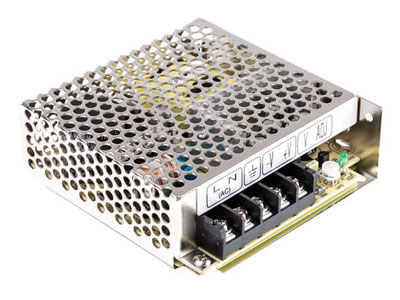Key Takeaway
Switch Mode Power Supplies (SMPS) are known for their higher efficiency, compact size, and reduced heat generation. They use high-frequency switching to convert electrical energy, making them ideal for modern electronics. On the other hand, Linear Power Supplies have a simpler design and are more cost-effective. They are preferred in applications where minimal noise is crucial. However, they are less efficient and larger compared to SMPS. In summary, SMPS is best for efficient, space-saving solutions, while Linear Power Supplies are suited for low-noise requirements.
Basic Definitions
A Switched-Mode Power Supply (SMPS) is a type of power supply that uses switching regulators to convert electrical power efficiently. It changes the voltage and current characteristics of electrical power using semiconductor switches.
On the other hand, a traditional power supply refers to linear power supplies which rely on transformer-based technology. They step down the voltage and use linear regulators to provide a constant DC output. These are more straightforward but typically less efficient compared to SMPS.
Understanding these basic definitions is crucial for any new engineer in the industry. SMPS is widely used in modern electronics due to its efficiency and compact design, while traditional power supplies are known for their simplicity and reliability.

Key Components of SMPS and Traditional Power Supplies
In the realm of industrial applications, understanding the key components of Switch Mode Power Supplies (SMPS) and traditional power supplies is crucial for designing and troubleshooting systems effectively. An SMPS comprises a switching regulator, inductors, transformers, and capacitors. The switching regulator’s role is to rapidly turn the current on and off, significantly reducing energy loss and boosting efficiency. Inductors and transformers manage energy storage and transfer, while capacitors are responsible for smoothing out the output, ensuring a consistent and reliable performance.
Conversely, traditional power supplies are built with a transformer, rectifier, filter, and voltage regulator. The transformer steps down the AC voltage, which the rectifier then converts to DC. The filter’s job is to reduce ripple, and the voltage regulator maintains a steady output. Each component’s function directly impacts the power supply’s overall efficiency and performance. By comprehending these roles, engineers can make informed decisions, whether designing new systems or troubleshooting existing ones in industrial applications.
Working Principles of SMPS and Traditional Power Supplies
Switch Mode Power Supplies (SMPS) operate on a principle of high-frequency switching using pulse-width modulation (PWM). This technique involves rapidly switching the input power on and off, minimizing energy loss and heat generation. The high-frequency operation allows for smaller and lighter components, which is particularly beneficial in compact electronic devices. This efficiency makes SMPS a preferred choice in environments where energy conservation and space are critical.
In contrast, traditional power supplies rely on linear regulation. The process begins with a transformer stepping down the AC voltage, followed by a rectifier converting it to DC. This DC voltage is then filtered and regulated to provide a stable output. Although this method is simpler and easier to understand, it is less efficient because excess energy is dissipated as heat. The distinct working principles of SMPS and traditional power supplies lead to significant differences in efficiency and size. SMPS’s high efficiency and compactness make it suitable for modern electronic applications, while traditional power supplies are favored in scenarios where robustness and simplicity are more important than efficiency.
Applications and Use Cases
Switch Mode Power Supplies (SMPS) find extensive use in various applications, from computers and televisions to battery chargers and industrial automation equipment. Their high efficiency and compact size make them ideal for modern electronic devices, where space and energy conservation are paramount. The versatility and adaptability of SMPS to different input voltages further enhance their applicability in diverse industrial scenarios, ensuring reliable performance across a wide range of conditions.
On the other hand, traditional power supplies are commonly employed in audio equipment, radio transmitters, and certain industrial machines. These power supplies are chosen for their robustness and simplicity, particularly in environments where efficiency is less of a concern. Their reliable performance in providing stable power output makes them suitable for applications where maintaining consistent operation is critical. Understanding the specific applications and use cases of both SMPS and traditional power supplies helps in selecting the right component for various industrial applications, ensuring optimal performance and reliability.
Advantages and Disadvantages
Switch Mode Power Supplies (SMPS) offer several advantages, including high efficiency, smaller size, and lighter weight. They are highly adaptable to different input voltages and provide a stable output, making them suitable for a wide range of industrial applications. However, SMPS are more complex, can generate electromagnetic interference (EMI), and require careful design to ensure reliability. These complexities can pose challenges in certain applications, necessitating a thorough understanding of their operation and potential issues.
In contrast, traditional power supplies are valued for their simplicity, robustness, and excellent noise performance. They are easier to design and maintain, making them a reliable choice in many industrial scenarios. However, they are larger, heavier, and less efficient compared to SMPS. The heat generated by traditional power supplies can be a drawback in compact or thermally sensitive applications. By weighing the advantages and disadvantages of each type, engineers can make informed decisions about which power supply to use in various industrial scenarios, balancing efficiency, complexity, and reliability to achieve the best results.
Conclusion
In summary, the Switched-Mode Power Supply (SMPS) and traditional power supplies each have their own strengths and weaknesses. SMPS offers high efficiency and compact size, making it suitable for modern electronic devices and systems. Traditional power supplies, while less efficient, provide robustness and simplicity, ideal for certain industrial applications.
Choosing the right power supply depends on the specific needs of the application. For high-efficiency, space-constrained environments, SMPS is the preferred choice. For applications where reliability and noise performance are critical, traditional power supplies may be more suitable.
Understanding these differences is essential for engineers to make informed decisions in their design and troubleshooting processes, ensuring optimal performance and reliability in their projects.
